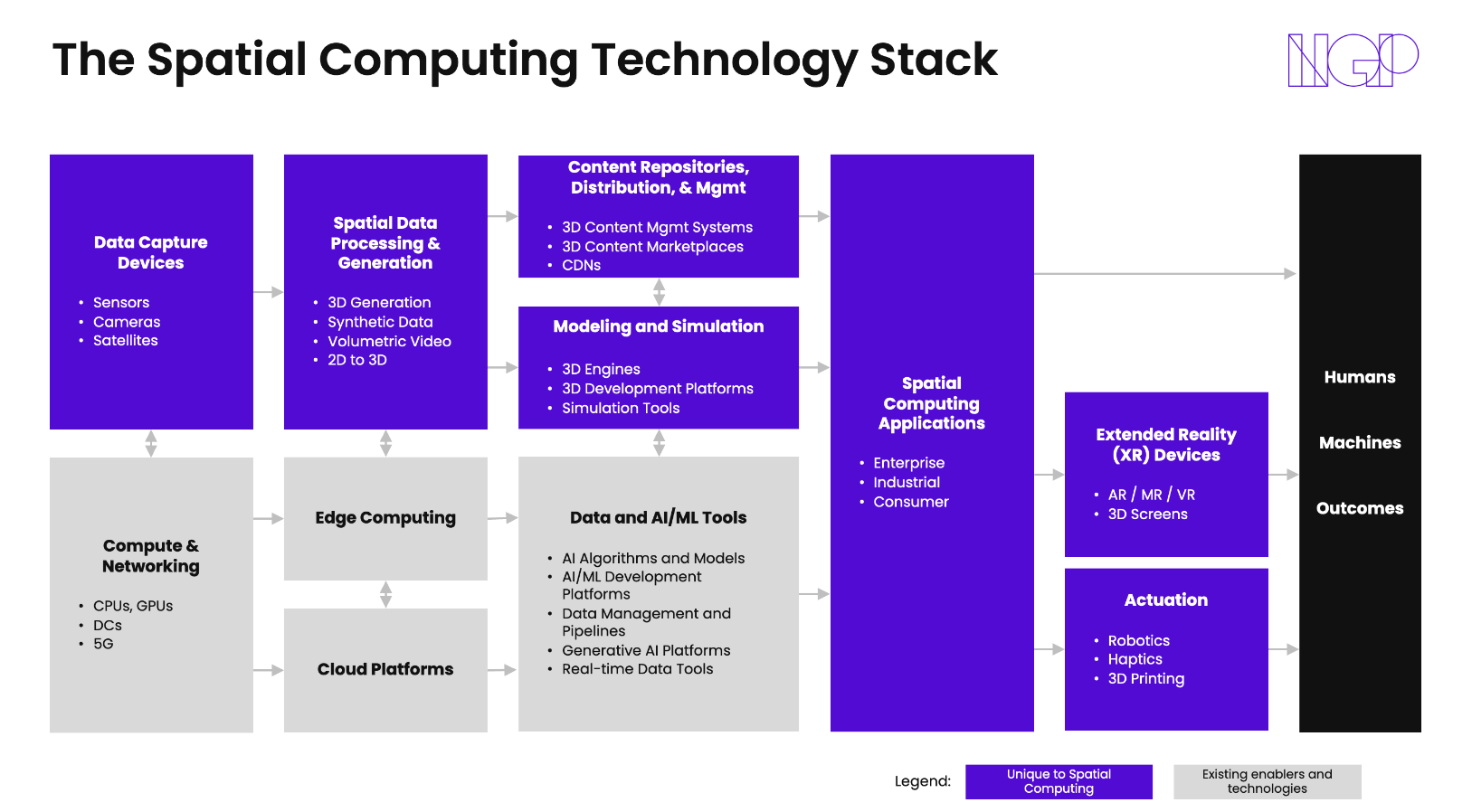
Spatial Computing: The Next Frontier of Computing?
Throughout the history of computing, one of the key driving forces has been the pursuit of ever-increasing levels of realism. In the early days, the graphics processing capabilities of computers were extremely limited. Games and applications first used only black-and-white text, and later simple shapes and colors to represent objects and characters. However, as processors and other enabling technologies advanced (Nvidia’s first GeForce GPU was introduced in 1999), developers were able to create graphics that started resembling the real world.
Today, most data and content we interact with remain confined to two dimensions, primarily images and videos. However, our physical world is comprised of three spatial dimensions. At NGP Capital, we believe spatial computing will be the next frontier for computing that will bring additional depth and immersion for data and content. When coupled with artificial intelligence, it is expected to have substantial implications across many industries. If a picture is worth a thousand words, a 3D model is surely worth a thousand pictures.
Let us go into the world of spatial computing, exploring its current state, key challenges, and prospects. We’ll put on our B2B (business-to-business) investor lens to analyze the space, highlighting key use cases, technologies, and applications of spatial computing.

Defining the Essence of Spatial Computing
Apple's 2023 announcement of the Vision Pro rekindled the interest towards spatial computing, solidifying Apple's commitment to this technology and its vast potential (by January 2024, Vision Pro pre-sales are estimated at ~200k devices exceeding analyst forecasts). However, the concept of spatial computing has a rich history, stretching back a couple of decades. The term was coined in 2003 by Simon Greenwold, a computer scientist and entrepreneur. He defined spatial computing as "human interaction with a machine in which the machine retains and manipulates referents to real objects and spaces."
While Greenwold's definition serves as a valuable foundation, we envision spatial computing as something far more expansive. It extends beyond human interaction, encompassing a vast array of concepts and technologies that facilitate the convergence of physical and digital worlds (our investment thesis we launched last year, see more here).
Three key primitives underpin spatial computing: 3D data, location, and time.
- 3D data adds an additional spatial dimension compared to images/videos enabling the creation and usage of highly immersive and rich content. his additional dimension comes at a cost, significantly increasing the demands for compute and storage. 3D is arguably the most fundamental of the three primitives spatial computing.
- Location is required for seamlessly and precisely overlaying virtual content onto the physical world. This is exemplified by industrial digital twins, where location accuracy down to the millimeter is needed for managing complex factory operations. Location data bridges the gap between the digital and physical realms, enabling real-time interaction and manipulation of virtual objects within real environments.
- Time is a crucial dimension for tracking change, identifying historical patterns, and predicting future outcomes.
In addition to these primitives, spatial computing is often associated with concepts and technologies such as extended reality (XR) technologies (including augmented reality, virtual reality, and mixed reality), AI/ML, sensors for data capture, and digital and fractionalized assets.
It is critical to note that spatial computing is not a mere rebranding of the metaverse. Where metaverse maximalists (including Meta itself) were painting a future picture of interconnected virtual worlds for everything, spatial computing remains firmly rooted in enabling applications today.
Spatial Computing Now?
Our discussions with dozens of entrepreneurs, industry experts, and leaders revealed that there’s a high degree of conviction that spatial computing can become the next major computing platform after smartphones. Spatial computing can provide more captivating experiences and makes computing more natural and accessible than before – even to the extent of making laptop and mobile device screens redundant. It enables capturing and presenting the physical reality in new ways breaking through the limitations of place and time.
However, as an investor, timing matters as much as the substance: many companies have failed because of being too early, take for example the implosion of Magic Leap in the arena of spatial computing. Therefore, the key question to ask is when all of this will happen? We currently observe two distinct levels of maturity in spatial computing, depending on the technologies and applications under consideration.
First, spatial computing can be viewed as immersive human experiences where XR devices provide a window into the digital world that’s overlaying the physical. From this perspective, spatial computing is still in a stage of experimentation with pioneering products like Apple Vision Pro and Xreal providing a glimpse into what this future might look like. The concept of dominant design is critical for understanding industry evolution and how the industry might play out. Typically, prior to the emergence of a dominant design in an industry, a diverse range of product variants exist. In the early days of the mobile phone, hundreds of mobile phone designs existed and competed – some were square, some round, some foldable, some not. However, after the iPhone was introduced in 2007, phone designs started converging, to the extent that nowadays it’s impossible to distinguish one brand from another. A dominant design had emerged, which along with operating system standardization and app stores created a foundation for further innovation in software and applications.
Although virtual reality (VR) devices like Meta Oculus and HTC Vive already exist, their applications are limited to use cases such as gaming and product design. We believe augmented reality (AR) devices are the key towards unlocking widespread adoption. However, significant technological hurdles persist before consumer-grade AR devices will become available, particularly related to lens production and overall miniaturization. Further development is also needed in the standardization of software (e.g. AR-native operating systems) and gesture-based interaction. Consequently, we believe a true dominant design in AR is still potentially 5-10 years away. Coupled with the typical 10–15-year timeframe for mainstream consumer adoption of new technologies, we believe this area of spatial computing is still early.
Second, spatial computing can be thought of broadly as applications and infrastructure that utilize 3D data, localization technologies, and time series data (where the use cases are not reliant on XR devices). From this perspective, we believe spatial computing is ripe for investment, and we are seeing a large and increasing number of use cases being deployed right now. While challenges, such as 3D stack standardization exist, we believe these are solvable in the short term through engineering work. See Figure 2 for a summary of the key use cases we identified during our research that are in production today.

The Market Landscape for Spatial Computing
The spatial computing landscape is evolving rapidly, driven by both startups and incumbents. Below, we present our view of the most significant segments within spatial computing alongside selected companies operating in each area (NGP Capital portfolio companies highlighted with a star).

The Technology Stack for Spatial Computing
The exploration of a new computing frontier would not be complete without diving into the technology stack that makes it tick. Figure 4 highlights the key components essential for building spatial computing products and experiences.
Beyond standard computing elements, spatial computing introduces several components unique to it. The most significant distinction, in our view, lies in the integration of 3D data. 3D data is demanding from a processing and storage perspective. Modern games, for example, are often tens or hundreds of gigabytes in size (in comparison, a typical mobile app is measured in tens or hundreds of megabytes, a factor of a thousand less). Capturing, processing, and distributing, and ultimately viewing this data requires specialized technologies.

Our Investment Principles for Spatial Computing
We at NGP Capital have been investing in spatial computing for more than a decade. For example, our portfolio company Scandit provides smart data capture software, which turns off-the-shelf mobile phones into professional grade computer vision devices, and enables consumers and workers to use mobile AR. Dataloop is a developer-focused platform for scaling vision AI into production. It provides unstructured data management, annotation tools, and data pipelines for industries like agriculture and automotive. NIL Technology is an optical solutions company that provides optical elements and waveguides for cameras and AR devices. Finally, Anybotics develops autonomous legged robots and software for industrial inspection.
We see incredible potential across the spatial computing landscape. Our investment principles in the space can be distilled into a set of four key criteria guiding our decision-making:
- Prioritize customer value and ROI. The spatial computing industry is rife with novel technologies looking for problems, which might not exist
- Focus on solutions that can scale independent of XR headset development and adoption. However, ideally the solutions will still benefit from XR once it matures.
- Look for teams and products solving core challenges of 3D data: unstructured data handling, large data volumes, low latency requirements, capturing and creating high-quality 3D content
- The next generation of spatial computing companies will utilize AI as a core part of their solutions. AI will transform the way content is created, captured, processed, and used
--
You have made it way to the end! If you are building a company in the spatial computing domain, we would love to hear from you so please reach out to ossi@ngpcap.com or one of my colleagues below. Also, please let us know if you have any feedback related to the post.
Thank you particularly to Divya Raghavan, Jacob Fellman, Fernanda Aguiar, Bo Ilsoe, Helmi Peräkylä, and Jiayi Ruan for significant contributions to the work.










.png)







